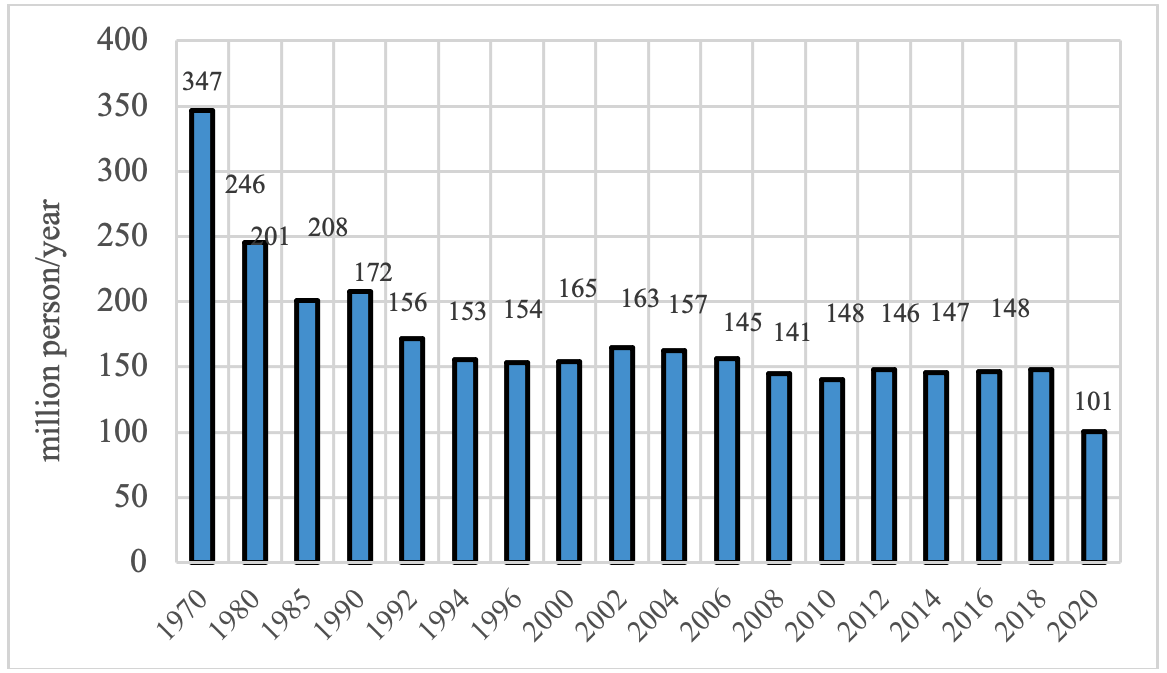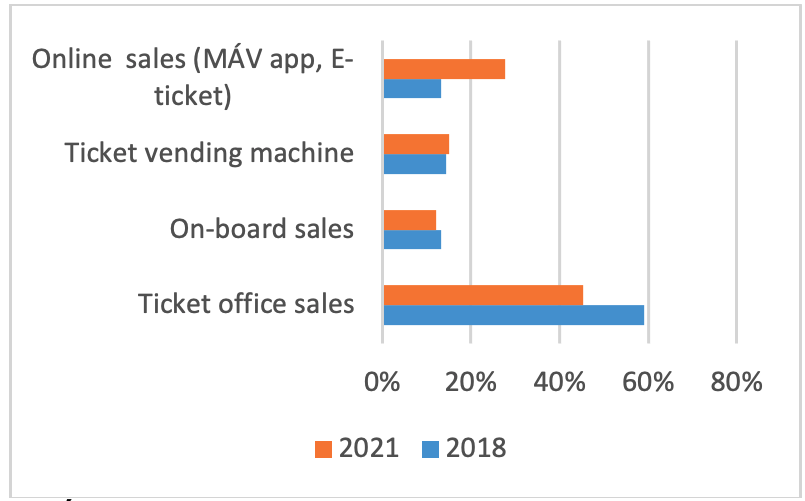APPLICATON OF ELECTRONIC TICKETING AT THE HUNGARIAN RAILWAY
Attila Erdei
Hungarian University of Agriculture and Life Sciences, Doctoral School of Economics and Regional Sciences
ABSTRACT
The expansion of cyberspace is playing an increasingly important role in electronic commerce of goods and services. Public transport cannot be excluded from this process, as service providers who recognized the benefits of the system in time and applied it, could gain a huge competitive advantage over their competitors. U.S. airlines first introduced e-commerce solutions in the early 1980s because competition was so fierce that market players had to seize all the means to reap the benefits. Today, the vast majority of airline ticket sales take place electronically. E-tickets also appeared in rail transport, with European distribution starting in the early 2000s. In the case of the railway, new methods had to be developed, especially for different travel habits, open access, and so on. Of course, in this case, too, capital-intensive and large passenger railway companies such as Deutsche Bahn (DB), Schweizerische Bundesbahnen (SBB) and Société Nationale des Chemins de Fer Français (SNCF) first introduced it. In Hungarian railway transport, electronic ticketing options were introduced few years later. Today, less than 60% of tickets and passes are sold in physical form at ticket offices. According to company statistics for 2021, the number of tickets and season tickets sold in alternative ways (vending machines, internet, application) is constantly increasing. The aim of my research is to investigate the challenges of the implementation of the electronic ticketing system and experience of its application at MÁV-START Zrt. In my research, I typically use secondary data, foreign scientific results, and internal data of the company.
Keywords: rail, electronic commerce, efficiency
1 INTRODUCTION
In transportation, the sale of e-tickets as a revolutionary innovation first appeared in the aviation industry in the United States in the 1980s. In 1984, United Airlines introduced the electronic ticketing service on an experimental basis. The trial period lasted 6 years, after which this form of ticketing was actually introduced in the live.
The airline’s courage and innovative idea provided a significant competitive advantage over its competitors. The industry has already undergone significant development during this period, showing a booming trend until the unfortunate events of 2001 (terrorist attacks against New York and Washington using planes).
Other airlines soon woke up to the huge potential of electronic, paperless ticketing systems (such as electronic documentation of sales, usage tracking, and billing processes). With this new method, passengers from anywhere in the world could book tickets online, pay for them and use their e-tickets after printing.
Due to the rapid changes of the technology, the role of the new online tools like social media and mobile applications formed a very strong influencing power on the customers’ decision making procedure on travelling. (Grotte 2015)
Electronic commercial opportunities were introduced in Hungarian railway transport a few years later. In my research, my goal is to analyse the challenges of the introduction of the electronic ticketing system and the experience of its application at MÁV-START Zrt. In my research, I typically use secondary data (internal data of the railway company).
2 Railway in hungary
In the more than 150 years since the handover of the first Hungarian railway line (Pest-Vác) in 1846, the continuously expanding Hungarian railway network was able to follow the needs of industrializing economy, while being the engine of the development of modern society.
The era of the Hungarian railways up to World War I coincided with the intensive integration of the country into the European economic system and the booming pace of rail transport as a developing transport sector in an international context. During this period, one of the basic conditions for the economic recovery of the country, individual regions and settlements was the construction of an adequate railway network and the establishment of a railway connection (Erdeiné Késmárki-Gally–Fenyvesi, 2012).
In response to this need, one of the most dynamically developing railway networks in contemporary Europe was created in a few decades (Köller, 2005).
The Hungarian railway network was established in sync with European development and until the World War II it was able to keep pace with technical developments (network density, proportion of double-track lines, proportion of electrified lines, speed allowed on the track, proportion of seamless superstructure, proportion of bulky rails, number of stations, level crossings, structures, interlocking, etc.).
Today, the MÁV Group is Hungary's largest and most important fixed-track transport service provider. The responsibilities of the 30 member companies of the company group include, among other things, the operation of the track network, passenger transport, traction, maintenance and vehicle production. On July 1, 2007, the passenger transport subsidiary, MÁV-START Zrt. was established, which serves passengers on the Hungarian 7,273 km railway network at a total of 1,344 points (railway stations, stops) every day, with thousands of trains a day. The company currently operates 1863 passenger cars, 467 motor cars and 976 (diesel / electric) locomotives (MÁV-START, 2021). The changes in recent decades (such as motorization, the development of transport, changes in travel habits and needs, digitalisation, environmental protection, etc.) are having an impact on the environment and challenging the railways to respond.
Examining the passenger transport data (Figure 1) it can be identified that the measured data has been steadily declined since the 1970s, and with the development of motorization, the railways have been gradually pushed out of the traditional transport market. With the emergence of the market economy in the 1990s, and the disappearance of the previously artificially maintained economic environment, the railways collapsed as the adverse effects on rail transport occurred simultaneously. After the deepest point of 2010, due to developments and railway renovations, the decline has stopped, and the number of passengers has even increased by about 10 million in the last 10 years. This promising trend was broken by the downturn caused by the Covid-19 epidemic in 2020.
Today, the Hungarian railway network is characterized by a central layout that follows the centrality of Budapest arising from historical and economic conditions of the country. A significant proportion of the transit and long-distance segments of rail passenger and freight transport affects the capital. The national network structure has a positive effect on the direct provision of agglomeration and long-distance connections for Budapest (Tóth et. al 2014). The central role of the capital culminates in commuting among employees and students. More than 50% of the domestic railway passenger traffic appears on the railway network of Budapest and its surroundings

Figure 1: Statistics on rail passenger transport (1970–2020; million persons/year)
Source: (Köller, 2005; KSH, 2021)
3 Electronic ticketing in passanger transport
3.1 Beginning by U.S. airlines
Business passengers accounted for a significant portion of U.S. air traffic (nearly 70%) in the 1980s. They had a higher level of IT and technological background, so they could more easily adapt to the new ticket booking system than the so-called ordinary passengers.
The main benefits of the system for passengers were the comfort and a safer travel. While traditional tickets had to be carried by passengers throughout their journey, the use of e-tickets stored in digital format in the central database reduced the chances of losing the ticket to a minimum. The only condition for using the ticket is that the user can credibly identify himself with the help of a suitable card.
The main function of a traditional ticket is to prove to the transport company that the passenger has paid for the trip, document the ticket sales and allow the management of free / booked seats. The e-ticket allows booking and tracking through a central database. For the airline, e-tickets provide a number of clear benefits, the most important of which are the reduction of paper production and handling costs, and the elimination of the possibility of counterfeiting paper-based tickets. The introduction of electronic tickets has significantly reduced the number of lost, stolen tickets and made the use of pre-exchanged tickets unnecessary.
The benefits of e-ticketing have been so great that the International Air Transport Association (IATA) has discontinued the sale and processing of paper tickets since December 2007 (Bisignani – Peters, 2005).
There are many types of “smart” tickets in their material appearance, but they can actually be divided into two main groups: “barcode” tickets and “smart card” tickets. Both types include encryption, making them harder to counterfeit than traditional paper-based tickets, and this reduces the chance of ticket misuse. Each “barcode” type ticket has a barcode that allows it to be read by the appropriate electronic device and the contents contained in it to be displayed. In contrast, in the case of “smart card” tickets, the ticket is recorded on a plastic card-sized plastic sheet, thus allowing contactless reading using radio waves.
3.2 Railway application in Europe (Deutsche Bahn)
The spread of IT systems also appeared in the sale of railway tickets. In the early 2000s, it was introduced at the most capital-intensive railway companies with high passenger traffic, such as the Deutsche Bahn (DB), the Schweizerische Bundesbahnen (SBB) and the Société Nationale des Chemins de Fer Français (SNCF). electronic ticketing.
The main features of an electronic train ticket are very similar to a plane ticket. Like airline tickets, Deutsch Bahn (DB) online tickets are paid for in advance by passengers. Each ticket is assigned a unique number (Passenger Number Record) (PNR) and customized for each booking (Ng-Kruelle et al., 2006).
However, the system of selling electronic rail tickets has shown significant differences from the sale of e-tickets in the aviation industry from the very beginning. Table 1 shows the differences between the two systems through the example of Deutsche Bahn.
Table 1. Comparison of e-ticketing systems for airlines and railways
|
|
Airlines - IATA |
Railways (DB Mobility specifically) |
|
Seat Reservation |
|
|
|
Checkpoint |
|
|
|
Ticket control |
|
|
|
Travel flexibility |
|
|
|
Online booking and cancellation |
|
|
Source: (Ng-Kruelle et al., 2006)
As it can be seen in Table 1, the biggest differences are in the accessibility (open / closed) and flexibility of the system.
3.3 Electronic ticket sales at MÁV-START Zrt
In recent years, the ticket sales of MÁV-START Zrt. Have undergone significant development. Following the international trends, sales of electronic tickets started at the end of 2011. Initially, it was possible to buy tickets online, print them at home or present them electronically on quality long-distance trains (IC, EC, EN, Express).
The biggest breakthrough came in November 2016, when the pdf-based electronic train ticket became available on all passenger trains of MÁV-START Zrt.
Another important sales opportunity for electronic sales is ticket vending machines, which are becoming more widespread across the country and, in addition to ticket purchase, also allow you to display timetable information and pick up tickets purchased online. Using MÁV-START ticket vending machines, tickets, season tickets, supplementary tickets, seat reservations, tickets for bicycle and live animals can be purchased for any domestic destination. The vending machines can be used to pay with cash and credit cards 24 hours a day, and it is possible to use contactless credit cards. The company recommends using of the vending machine to avoid having to queue at the ticket office, which not only saves time, but also money, since they offer a 5% discount off the ticket office price for these purchases.
The latest and most dynamically developing sales channel is the Internet electronic ticket purchase application, which has received almost 2.5 million purchase transactions in the past year, with a total value of approximately HUF 1.2 billion.

Figure 2: MÁV-START ticket sales channels in 2018 and 2021 (percent)
Source: Self-editing based on MÁV-START internal data (2021)
In addition to buying tickets, it also has a timetable finder and a map train tracking system. Since the launch of the timetable and map passenger information application and the introduction of e-train tickets, there has been a great demand from passengers to be able to buy tickets in the mobile phone application as well. MÁV-START has therefore expanded its very popular mobile application with 400,000 downloads with the ticket purchase function.
In December 2020, at the same time as its new schedule came into force, MÁV announced a significant change in its online ticket sales system. After more than a decade, the company's Elvira ticketing system has finally received a new, modern interface. In this context, Hungary's first full-offer online ticketing interface will be completely renewed this year: the new Elvira will already operate in the railway company's unified ticketing system, connected to the MÁV mobile application, so passengers can use both on their own or independently.
The most striking change when using the new Elvira is the modern, clean interface. The other key development is that users can use a common user account with the MÁV application, so the ticket purchased on the new Elvira can also be displayed in the MÁV app and received in PDF format by e-mail. This allows the ticket to be downloaded, printed, or forwarded to the person in whose name it is addressed.
They can manage their shopping and travel data in a single convenient interface, and can be modified by passengers if necessary. Users can initiate a refund for tickets purchased online on any interface, provided that this option was not excluded in the terms of purchase. Users can also use their saved billing and credit card information for both the web and app. Tickets can be purchased later on the new Elvira, but this feature is still available in the MÁV app.
In the recent period, the MÁV mobile application has been expanded with several important innovations. After the latest version update, in the case of domestic railway tickets redeemed in the MÁV application and some international START offers, the e-mail confirming the successful purchase also contains the tickets in PDF format. These can be printed out during the inspection or on the screen of a suitable device.
Modern, electronic ticket purchase is not only available for domestic trips, but also for those traveling abroad and foreigners traveling to Hungary.
START Europa tickets provide the best prices to Austria, Germany, Switzerland, Czech Republic, Slovakia, Poland and Romania from Hungary. The company’s cash decks sell tickets from nearly every Hungarian station to nearly every one of the destination countries – or return. To destinations, accessible by direct day trains tickets are also available from the online sales system and mobile app „MÁV”. START tickets in the app can be purchased only for the direct trains. Free seat reservation is included. Children traveling with adults, who have START Europa ticket, can get a ticket to Austria, Germany, Switzerland, Czech Republic and Slovakia for 5 € on 2nd class and for 10 € on 1st class. Price of child tickets to Romania and Poland depends on distance. With an adult holding a START ticket maximum three children can travel between the age of 6–14. (MÁV-START, 2021)
4 Conclusions
Maintaining and increasing the market share of the railway in transport is expected only if a quality service is implemented. Its main features: adequate frequency, punctual timetable, punctuality, modern, clean, comfortable fleet, safe take-off and landing conditions, intermodality with short walking distances, complex service at stations, P+R, B+R option, load handling, ticketing development of channels.
Improving the service level is one of the most important objectives of the Hungarian railway company. In addition to infrastructure and vehicle improvements, this is why the development of ticketing channels has also appeared. With the traditional sales methods for today's X, Y, Z generation – where the use of a smartphone or laptop is almost a necessity – it is not possible to increase the use of the service. It is therefore important that they have a high quality, reliable and reliable ticketing system.
This development is particularly important in the agglomeration of the capital, where more than 10,000 people use the services of the railway company every day.
Online ticketing is becoming more and more popular among passengers. According to the latest statistical data, the number of tickets and season tickets sold in alternative ways (automatic, internet, MÁV app) is constantly increasing.
The popularity of the e-train ticket is due not only to its speed and convenience, but also to the discounts given to passengers. With the significant discount, the railway company aims to make convenient and modern ticketing solutions even more attractive, thus reducing the workload of ticket offices and convincing new passengers that it is worth choosing the railway.
The railway company’s medium- and long-term goal is to reduce the use of traditional ticketing methods, while further increasing the proportion of modern, convenient and cheaper ways of shopping.
REFERENCES
Bisignani, G. & Peters, J. (2005): Change is in the air. Economists, Technology Quarterly, pp. 19-21. https://www.economist.com/technology-quarterly/2005/03/12/change-is-in-the-air
Erdeiné Késmárki-Gally, Sz. & Fenyvesi, L. (2012): Tendencies and challenges in global agriculture. Problems of World Agriculture: Scientific Journal of Warsaw University of Life Sciences 27:12, pp. 47-53.
Grotte, J. (2015) :New Trends in the Hospitality Industry JOURNAL OF TOURISM RESEARCH 2015 : 11 pp. 174-189.
Köller, L. (2005): The line and network efficiency of different railway networks and the interpretation of competitiveness in railway based on domestic experience and international examples (in Hungarian). p. 66. http://www.vki.hu/~tfleisch/~haver/szakirodalom/haver-KOLLER-vasut.pdf (May 3, 2021)
MÁV-START Zrt. (2021): Internal materials, data
Ng-Kruelle, G. & Swatman, P.A. & Kruelle, O. (2006): e-Ticketing Strategy and Implementation in an Open Access System: The case of Deutsche Bahn. https://www.researchgate.net/publication/228883725 (May 3, 2021)
Tóth, G. & Dávid, L. & Vasa, L. (2014): The role of transport European tourism flows. Acta Geographica Slovenica 54:2, pp. 311-320.
